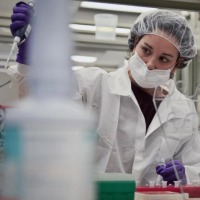FBI Errors Lead to Discovery that DNA Evidence May be Far Less Foolproof When It Includes More than One Person
 Forensic science criminalist performs DNA testing (photo: Bebeto Matthews, AP)
Forensic science criminalist performs DNA testing (photo: Bebeto Matthews, AP)
Relying on DNA evidence for criminal cases is great when the evidence being tested is from only one subject. But mix in samples from multiple people and it turns out that the results are a lot more fuzzy.
The issue of testing mixed DNA arose after the Federal Bureau of Investigation (FBI) found 51 errors in its DNA database out of tens of thousands of entries, according to the blog Grits for Breakfast, which focuses on issues of Texas criminal justice.
The FBI claimed the errors were insignificant, an assessment disputed by some criminal justice experts, such as Lynn Garcia of the Texas Forensic Science Commission (FSC). Garcia found, according to the blog, “the largest discrepancy estimated from the data-entry errors would have reduced a likelihood of one in 260 billion that it belonged to another person to one in 225 billion. With seven billion people on the planet, that looked like a yawner.”
But then “some Texas prosecutors asked for their probabilities to be recalculated” and after that was performed, the numbers changed dramatically.
“The most radical difference,” Scott Henson wrote at Grits for Breakfast, involved a case “where a one-in-a-billion probability was lowered to around one-in-fifty.” That caused prosecutors and the FSC to perk up and take notice.
The difference “stemmed not from the data entry errors but because … the FBI had changed its methodology for calculating probabilities in mixed DNA samples and moved to a new method which they considered more accurate,” Henson wrote.
The change could mean that people convicted with mixed DNA evidence might have cause for a new trial.
In a letter to prosecutors, defense attorneys and others, Garcia wrote: “We therefore recommend any prosecutor, defendant or defense attorney with a currently pending case involving a DNA mixture in which the results could impact the conviction consider requesting confirmation that CPI (combined probability of inclusion) was calculated by the laboratory using current and proper mixture interpretation protocols. If the laboratory is unable to confirm the use of currently accepted protocols for the results provided, counsel should consider requesting a re-analysis of CPI.”
-Noel Brinkerhoff, Steve Straehley
To Learn More:
A Reluctant Scoop: Changing Interpretations of DNA Mixtures Vex Legal System (by Scott Henson, Grits for Breakfast)
Unintended Catalyst: the Effects of 1999 and 2001 FBI STR Population Data Corrections on an Evaluation of DNA Mixture Interpretation in Texas (Texas Forensic Science Commission)
Federal Court Rules that Improved DNA Testing Technology Means Forensic Samples from Past Crimes Must be Treated as New Evidence (by Noel Brinkerhoff and Danny Biederman, AllGov)
300th Wrongly Convicted American Released Thanks to DNA Evidence (by Matt Bewig, AllGov)
- Top Stories
- Unusual News
- Where is the Money Going?
- Controversies
- U.S. and the World
- Appointments and Resignations
- Latest News
- Trump Goes on Renaming Frenzy
- Trump Deports JD Vance and His Wife
- Trump Offers to Return Alaska to Russia
- Musk and Trump Fire Members of Congress
- Trump Calls for Violent Street Demonstrations Against Himself






Comments